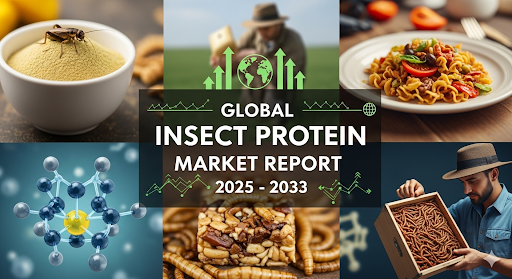
The global insect protein market is experiencing remarkable growth, driven by increasing awareness of its nutritional benefits and environmental sustainability. In 2024, the market reached a value of USD 1,171.4 million and is projected to expand to USD 5,528.0 million by 2033, exhibiting a CAGR of 18.82% during 2025-2033. Factors such as the demand for alternative protein sources, the rising prevalence of chronic conditions, and advancements in insect farming technologies are propelling this growth.
Study Assumption Years
- Base Year: 2024
- Historical Years: 2019-2024
- Forecast Years: 2025-2033
Insect Protein Market Key Takeaways
- The market is projected to grow from USD 1,171.4 million in 2024 to USD 5,528.0 million by 2033, at a CAGR of 18.82%.
- Europe leads the market due to strong regulatory support, high consumer awareness, and advanced R&D infrastructure.
- Animal nutrition is the largest application segment, with significant use in aqua feed and poultry feed.
- Offline distribution channels dominate, reflecting consumer preference for in-person purchases.
- Orthoptera is the fastest-growing source segment, while Coleoptera remains the largest by revenue.
- Technological advancements are enhancing production efficiency and product quality.
- Growing consumer acceptance is expanding the market across various regions.
Market Growth Factors
- High-Protein Flour Blends: Cricket Flour, Mealworm Flour, and Beyond
High-protein flour blends are transforming the insect protein market by turning insects into a tastier and more discreet ingredient, which helps more consumers in Western markets embrace them. This wider market reach is made possible by adding insect powder to familiar foods like baked goods, pasta, and snacks, cleverly bypassing the mental block many have about eating whole insects. Additionally, these blends give manufacturers the chance to promote the high nutritional value and sustainability of insects, appealing to those who care about health and the environment. By diversifying how these products are used and increasing production, insect flour blends also create new revenue opportunities in both human and animal nutrition, driving growth in the market.
- Insect Protein in Aquaculture Feed: A Sustainable Solution for Fisheries
The use of insect protein meal in aquaculture feed is boosting the insect protein market by replacing ingredients that are tough on resources. It not only provides solid nutritional and health benefits for fish but also shines a light on sustainability. This strategy helps avoid the typical consumer hesitance about eating insects directly, positioning insect protein as an essential, reliable, and eco-friendly ingredient in a rapidly expanding global industry. By converting food waste into valuable protein, insect-based feed is tackling key sustainability challenges in aquaculture, which is fueling significant market growth.
- Functional Supplements for Gut and Immune Health Backed by Insect Protein
Just like flour and animal feed, using insect protein in functional supplements for gut and immune health can really boost the market. By presenting these ingredients in a more tasty and familiar way, we can help consumers get past their aversion to whole insects. This strategy cleverly taps into the insect’s high nutritional and bioactive qualities, including prebiotic chitin and antimicrobial peptides, to meet specific health needs. It’s a smart way to reach niche, health-conscious consumers who are already looking for functional ingredients, such as fitness lovers and those with digestive issues. This drives market acceptance based on real health benefits, not just sustainability. Insect proteins are rich in unique compounds that have been shown to benefit gut and immune function.
Unique Bioactive Compounds in Insect Protein
Chitin: It is a vital part of insect exoskeletons, along with its derivative chitosan, which serves as a prebiotic fiber that can influence the gut microbiota. Research involving humans has indicated that adding cricket powder to the diet can boost the levels of beneficial gut bacteria, like Bifidobacterium animalis, which in turn supports both gastrointestinal health and immunity.
Antimicrobial peptides (AMPs): Insects produce a wide array of AMPs as part of their immune defense. These peptides have shown antimicrobial effects against various pathogens, suggesting their potential to improve gut health and strengthen the immune system.
Anti-inflammatory peptides and lipids: Peptides and beneficial lipids, such as omega-3 fatty acids from insects, have been found to have anti-inflammatory effects. It’s really important to reduce inflammation in the gut and across the body to support our immune health and help prevent chronic illnesses.
Request for a sample copy of this report:
https://www.imarcgroup.com/insect-protein-market/requestsample
Market Segmentation
Breakup by Source:
- Coleoptera: Beetles are widely used due to their high protein content and ease of farming.
- Lepidoptera: Moths and butterflies are explored for their potential in various applications.
- Hymenoptera: Includes ants, bees, and wasps, known for their nutritional value.
- Orthoptera: Grasshoppers and crickets are popular for their high protein and low fat content.
- Hemiptera: True bugs are considered for their protein-rich profiles.
- Diptera: Flies, especially black soldier flies, are efficient in waste conversion and protein production.
- Others: Includes various other insect species under research for protein extraction.
Breakup by Distribution Channel:
- Offline: Traditional retail outlets where consumers can physically assess products.
- Online: E-commerce platforms offering convenience and a wide range of products.
Breakup by Application:
- Animal Nutrition:
- Aqua Feed: Insect protein is used in fish and shrimp feed for its digestibility and growth benefits.
- Poultry Feed: Enhances poultry health and growth rates.
- Others: Includes pet food and livestock feed applications.
- Food and Beverages: Incorporation into snacks, protein bars, and other food products.
- Pharmaceutical and Supplements: Used in dietary supplements for its nutritional benefits.
- Personal Care and Cosmetics: Applied in skincare products for its protein content.
Breakup by Region:
-
- North America (United States, Canada)
- Asia Pacific (China, Japan, India, South Korea, Australia, Indonesia, Others)
- Europe (Germany, France, United Kingdom, Italy, Spain, Russia, Others)
- Latin America (Brazil, Mexico, Others)
- Middle East and Africa
Regional Insights
Europe dominates the insect protein market, driven by supportive regulations, high consumer awareness, and significant investments in sustainable food technologies. The region’s advanced R&D infrastructure and progressive policies facilitate the growth and acceptance of insect-based products.
Recent Developments & News
The insect protein industry is witnessing rapid advancements, with companies investing in large-scale production facilities and innovative product development. Technological innovations are enhancing the efficiency and scalability of insect farming, while increasing consumer acceptance is expanding market reach. These developments are positioning insect protein as a mainstream, sustainable protein source.
Key Players
Aspire Food Group, Chapul LLC, Entomo Farms, EnviroFlight LLC (Darling Ingredients), Goterra, Hexafly, InnovaFeed SAS, Jimini’s, nextProtein, Protenga, Protix B.V., etc.
Ask Analyst for Customization:
https://www.imarcgroup.com/request?type=report&id=12058&flag=C
If you require any specific information that is not covered currently within the scope of the report, we will provide the same as a part of the customization.
About Us:
IMARC Group is a global management consulting firm that helps the world’s most ambitious changemakers to create a lasting impact. The company provides a comprehensive suite of market entry and expansion services. IMARC offerings include a thorough market assessment, feasibility studies, company incorporation assistance, factory setup support, regulatory approvals and licensing navigation, branding, marketing and sales strategies, competitive landscape, and benchmarking analyses, pricing and cost research, and procurement research.
Contact Us:
IMARC Group
134 N 4th St. Brooklyn, NY 11249, USA
Email: sales@imarcgroup.com
Tel No:(D) +91 120 433 0800
United States: (+1-201971-6302)


